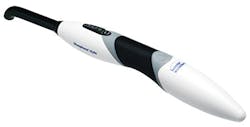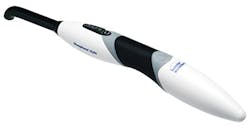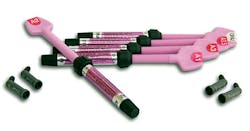Pearls for your practice
Joshua Austin, DDS, FAGD
Ivoclar Vivadent's Bluephase Style
In my dental practice, and probably in yours, so much relies on bonding. And if you can't cure well, you can't bond well. Posterior bulk-fill composites have become common in my practice, as they probably have in the practices of most other restorative dentists. But without adequate curing power, bulk-fill posterior composites are doomed to fail. In my opinion, that makes the curing light the most important piece of equipment in today's restorative dental office. It is, oftentimes, the piece of equipment that we most take for granted. When was the last time you checked the output power on your curing light? For a vast number of dentists, the answer is never. I was that way once too. Then, one day, I finally decided to check my curing light on a whim. It was putting out a quarter of the power it should. Apparently, my assistant had dropped it and broken the light guide and glued it back together without telling me. At that output, there was no way it was curing the composites I placed during that period. I replaced that light with an Ivoclar Vivadent Bluephase Style curing light and have been extremely happy ever since.
Ergonomic and stylish, the Bluephase Style is a wireless, LED curing light with a broad wavelength of light emission that has been designed to cure a vast majority of the light-cured materials we use today. Most LED lights have a narrower spectrum of wavelength, but the Bluephase Style has a halogen-like spectrum (385-515 nm). In addition to its broad spectrum, it has plenty of power. With a light intensity between 1,000-1,200 mW/cm2 and a 10 mm light guide that helps to focus the light on the tooth, it can cure deeply and quickly. The battery is solid and holds a charge for a long time. If, by chance, your battery runs out, the Bluephase Style can be converted into a wired light quickly so that you aren't left with a dead curing light. What an awesome feature!
The Bluephase Style has become my favorite curing light on the market. It has the broad-spectrum wavelength and power I need - all in a cool, stylish package that is a joy to use!
Home run for Ivoclar on the Bluephase Style curing light!
Estelite Sigma Quick by Tokuyama
I have to be honest here. I had never heard of Tokuyama until a few months ago. I was at a Texas Academy of General Dentistry MasterTrack hands-on course about anterior composites. The speaker's material of choice was a Tokuyama composite, and there was a large variety set out for the hands-on course. Thoroughout the weekend, we used the entire line of Tokuyama composite and bonding materials. I was thoroughly impressed with their products. For everyday, one- or two-shade composites, Tokuyama's Estelite Sigma Quick is a fabulous material.
Estelite Sigma Quick is labeled as a supra-nano, spherically filled universal composite. The spherical filler is meant to provide a more uniform diffusion of light, allowing for a more forgiving shade match and superior blend with natural tooth structure. In addition, it has a low volumetric shrinkage rate - 1.3% - based on the manufacturer's proprietary data.
The material handles well and can be sculpted easily. It is firm enough that slumping is not an issue, but not so firm that it can't be packed into the preparation. I found its handling to be superior to most other esthetic composites I have tried. Where Estelite really excels, though, is in polishing. This stuff probably polishes better than any other composite I have ever used. For anterior restorations, it's a dream.
Estelite Sigma Quick is the material of choice for everyday anterior composites. If you want to do a multishade, polychromatic anterior composite with a wax-up and four to five different layers of composite, the Estelite Omega would be the material to use instead. Most of us have a hard time justifying and getting reimbursed for complex anterior composites like that, however, which is why the Estelite Sigma Quick is such a nice option to have around. With one or two shades of composite, you can get a well adapted, superbly polished anterior restoration that matches and blends well. That's hard to beat. Cost-wise, Estelite is consistent with and similar to other esthetic composites such as Filtek Supreme and Esthetix HD. Estelite Sigma Quick by Tokuyama definitely has won me over! Solid double into the gap!
EdgeEndo's EdgeFile
Endodontics is always an interesting topic with general dentists. Some general dentists love endo and can't get enough. Others can't get their patients over to the endodontist quickly enough. What we can all agree on is that endodontic procedures can be among the most profitable procedures we perform because they do not require any lab fees. Instead, rotary files tend to be the most costly aspect of endodontic procedures.
Rotary files are now considered the standard-of-care for endodontics. Much conjecture occurs about how many times rotary endodontic files can be used. I think the cost of rotary files is part of the reason for this debate. Many of these systems can run between $40 and $50 per set of files. If you use each set just once, the procedures definitely generate some overhead. Now, the purpose of this Pearl is not to advise you to use your files once or more than once or a hundred times. That is a call that you have to make based on your experience, what type of endo you are doing, etc. But if we can help save you a little here and there on what you pay for rotary files, your overhead will go down - no matter what.
Many of the most popular endodontic files had patents that recently expired. That means that other companies can begin to manufacture these files. When competition increases, cost decreases. EdgeEndo is the first to try to reduce the overhead costs associated with endo. EdgeEndo has four different file systems made to mimic the most popular endo systems on the market today. If you are using WaveOne, ProTaper Universal, GT or GT Series X, Vortex, ProFile, K3, or EndoSequence ... good news! EdgeEndo makes a file that is compatible with your system. Using the handy table at edgeendo.com, you can select the right EdgeEndo file for you.
Based on the results of a proprietary cyclic fatigue study, EdgeEndo claims that its files are stronger and more durable than those of its competitors. Now, I can't substantiate this claim based on the handful of root canals I did with their files, but I did call a couple of the endodontists I refer to and asked their opinions. Both endodontists are knowledgeable and skilled clinicians. Both said that they have incorporated EdgeEndo files into their regular armamentariums.
I think EdgeEndo files are a great choice for dentists who are comfortable with cleaning and shaping with their current rotary endo systems but who are also interested in reducing overhead. Line-drive triple for EdgeEndo files!




